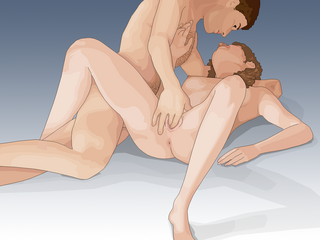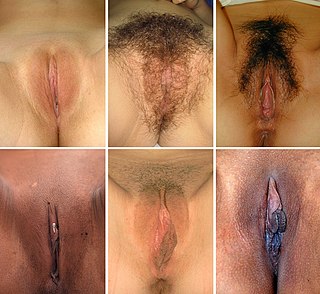Related Research Articles

A phobia is an anxiety disorder, defined by an irrational, unrealistic, persistent and excessive fear of an object or situation. Phobias typically result in a rapid onset of fear and are usually present for more than six months. Those affected go to great lengths to avoid the situation or object, to a degree greater than the actual danger posed. If the object or situation cannot be avoided, they experience significant distress. Other symptoms can include fainting, which may occur in blood or injury phobia, and panic attacks, often found in agoraphobia and emetophobia. Around 75% of those with phobias have multiple phobias.

In mammals and other animals, the vagina is the elastic, muscular reproductive organ of the female genital tract. In humans, it extends from the vestibule to the cervix. The outer vaginal opening is normally partly covered by a thin layer of mucosal tissue called the hymen. At the deep end, the cervix bulges into the vagina. The vagina allows for copulation and birth. It also channels menstrual flow, which occurs in humans and closely related primates as part of the menstrual cycle.

Pussy is a term used as a noun, an adjective, and—in rare instances—a verb in the English language. It has several meanings, as slang, as euphemism, and as vulgarity. Most commonly, it is used as a noun with the meaning "cat", "coward", or "weakling". In slang usage, it can mean "vulva or vagina" and less commonly, as a form of synecdoche, meaning "sexual intercourse with a woman". Because of its multiple senses including both innocent and vulgar connotations, pussy is often the subject of double entendre.
Dyspareunia is painful sexual intercourse due to medical or psychological causes. The term dyspareunia covers both female dyspareunia and male dyspareunia, but many discussions that use the term without further specification concern the female type, which is more common than the male type. In females, the pain can primarily be on the external surface of the genitalia, or deeper in the pelvis upon deep pressure against the cervix. Medically, dyspareunia is a pelvic floor dysfunction and is frequently underdiagnosed. It can affect a small portion of the vulva or vagina or be felt all over the surface. Understanding the duration, location, and nature of the pain is important in identifying the causes of the pain.
Erotophobia is a term coined by a number of researchers in the late 1970s and early 1980s to describe one pole on a continuum of attitudes and beliefs about sexuality. The model of the continuum is a basic polarized line, with erotophobia at one end and erotophilia at the other end.
Sexual dysfunction is difficulty experienced by an individual or partners during any stage of normal sexual activity, including physical pleasure, desire, preference, arousal, or orgasm. The World Health Organization defines sexual dysfunction as a "person's inability to participate in a sexual relationship as they would wish". This definition is broad and is subject to many interpretations. A diagnosis of sexual dysfunction under the DSM-5 requires a person to feel extreme distress and interpersonal strain for a minimum of six months. Sexual dysfunction can have a profound impact on an individual's perceived quality of sexual life. The term sexual disorder may not only refer to physical sexual dysfunction, but to paraphilias as well; this is sometimes termed disorder of sexual preference.

The female reproductive system is made up of the internal and external sex organs that function in the reproduction of new offspring. The human female reproductive system is immature at birth and develops to maturity at puberty to be able to produce gametes, and to carry a fetus to full term. The internal sex organs are the vagina, uterus, fallopian tubes, and ovaries. The female reproductive tract includes the vagina, uterus, and fallopian tubes and is prone to infections. The vagina allows for sexual intercourse and childbirth, and is connected to the uterus at the cervix. The uterus or womb accommodates the embryo, which develops into the fetus. The uterus also produces secretions, which help the transit of sperm to the fallopian tubes, where sperm fertilize ova produced by the ovaries. The external sex organs are also known as the genitals and these are the organs of the vulva including the labia, clitoris, and vaginal opening.
Genital reconstructive surgery may refer to:

The labia are the major externally visible portions of the vulva. In humans and other primates, there are two pairs of labia: the labia majora are large and thick folds of skin that cover the vulva's other parts while the labia minora are the inner folds of skin between the outer labia that surround and protect the urethral and vaginal openings.
Vulvitis is inflammation of the vulva, the external female mammalian genitalia that include the labia majora, labia minora, clitoris, and introitus. It may co-occur as vulvovaginitis with vaginitis, inflammation of the vagina, and may have infectious or non-infectious causes. The warm and moist conditions of the vulva make it easily affected. Vulvitis is prone to occur in any female especially those who have certain sensitivities, infections, allergies, or diseases that make them likely to have vulvitis. Postmenopausal women and prepubescent girls are more prone to be affected by it, as compared to women in their menstruation period. It is so because they have low estrogen levels which makes their vulvar tissue thin and dry. Women having diabetes are also prone to be affected by vulvitis due to the high sugar content in their cells, increasing their vulnerability. Vulvitis is not a disease, it is just an inflammation caused by an infection, allergy or injury. Vulvitis may also be symptom of any sexually transmitted infection or a fungal infection.

Fingering is sexual stimulation of the vulva or vagina by using the fingers. Vaginal fingering is legally and medically called digital penetration or digital penetration of the vagina. The term "digital" takes its significance from the English word 'digit', which refers to a finger, thumb, or toe. Fingering may also include the use of fingers to stimulate the anus.
Sexual anorexia is a term coined in 1975 by psychologist Nathan Hare to describe a fear of or deep aversion to sexual activity. It is considered a loss of "appetite" for sexual contact, and may result in a fear of intimacy or an aversion to any type of sexual interaction. The term largely exists in a colloquial sense and is not presently classified as a disorder in the Diagnostic Statistical Manual.
A reproductive system disease is any disease of the human reproductive system.
A vaginal disease is a pathological condition that affects part or all of the vagina.

In mammals, the vulva consists of the external female genitalia. The human vulva includes the mons pubis, labia majora, labia minora, clitoris, vulval vestibule, urinary meatus, the vaginal opening, hymen, and Bartholin's and Skene's vestibular glands. The urinary meatus is also included as it opens into the vulval vestibule. The vulva includes the entrance to the vagina, which leads to the uterus, and provides a double layer of protection for this by the folds of the outer and inner labia. Pelvic floor muscles support the structures of the vulva. Other muscles of the urogenital triangle also give support.
The following outline is provided as an overview of and topical guide to human sexuality:

Vulva activism is the promotion of a raised awareness of the appearance of female genitalia and the breaking of taboos surrounding the vulva, as carried out by feminist movements and advocacy groups. Other names for this advocacy movement are labia pride, labia liberation, vulvaversity, viva la vulva, pussy positivity and similar. It is supported by several independent feminist groups and based on diverse channels of communication such as cyberfeminism, protest marches and advocating boycotts against physicians and clinics that make use of deceptive advertising.

The vagina and vulva have been depicted from prehistory onwards. Visual art forms representing the female genitals encompass two-dimensional and three-dimensional. As long ago as 35,000 years ago, people sculpted Venus figurines that exaggerated the abdomen, hips, breasts, thighs, or vulva.
Phallophobia in its narrower sense is a fear of the penis and in a broader sense an excessive aversion to masculinity.
References
- ↑ Basavanna, M (2000). Dictionary of Psychology. p. 136.
- ↑ Bullough, Bonnie (2014). Human Sexuality: An Encyclopedia. Routledge. p. 626. ISBN 9781135825096.
- 1 2 Doctor, Ronald Manual (2010). The Encyclopedia of Phobias, Fears, and Anxieties, Third Edition. p. 251.
- ↑ Davidson, Michele (2012). A Nurse's Guide to Women's Mental Health. Springer. p. 209. ISBN 9780826171139.
- ↑ Waters, Richard (2004). Phobias: Revealed and Explained. p. 106.
- ↑ Kent, Fraser (1977). Nothing to Fear: Coping With Phobias. p. 184.
- ↑ American Journal of Psychotherapy - Volume 25. 1971. p. 657.
- 1 2 Ruben, Douglas (2001). Treating Adult Children of Alcoholics: A Behavioral Approach. p. 87.
- ↑ Gibellini, Pietro (2015). Sex in Belli's Rome: Eros, Social Groups and Religion. p. 59.
- ↑ "Kenapa Sih Ada Pria yang Justru Ketakutan saat Melihat Kelamin Wanita?". Tribun Lampung. 2014-12-25.
mengapa ini masih menjadi masalah bagi laki-laki dan perempuan ... seorang dokter baru merasa takut melihat kelamin perempuan ketika mereka bekerja melalui rotasi kebidanan ... Tapi fakta menunjukkan beberapa calon dokter akan berhenti sekolah medis jika mengalami masalah ini.
- ↑ "Cele mai ciudate fobii sexuale". Ele.ro.
femeile care nu-si pot controla aceasta frica au tendinta de a-si mutila organele genitale, ceea ce poate duce la nasterea unui copil cu probleme, durere la urinare sau probleme legate de menstruatie ... "Eurotophobia" poate fi legata de educatia primita in copilarie, in familii severe, pentru care organul sexual este considerat a fi ceva "murdar".
- ↑ Dudy, Mary (2013). The Moral Panics of Sexuality. Springer. p. 29. ISBN 9781137353177.
- ↑ Journal of the Institute of Romance Studies, Volume 5. 1998. p. 252.
- ↑ Faller, Kathleen Coulborn. "The Causes of Sexual Abuse." Child Sexual Abuse. Macmillan Education UK, 1988. 89-115.
- ↑ Robertson, John G (2003). An Excess of Phobias and Manias. p. 82.
- ↑ Iva Cheung (6 November 2015). "Where did the word cooties come from?". Slate Magazine.
Snapping turtle began to be used in the South as a eurotophobic euphemism for vagina, and cooter eventually took on the same meaning
- ↑ "9 Fobia Seksual yang Bikin Orang Takut dengan Hubungan Intim". liputan6.com. 12 April 2013.
- ↑ "Lifeissues.net | Planned Parenthood's Website "Glossary" - Fake Science, Phobias, and Sexually Obsessive Definitions".
- ↑ Fahs, Breanne. "Genital panics: Constructing the vagina in women's qualitative narratives about pubic hair, menstrual sex, and vaginal self-image." Body image 11.3 (2014): 210-218
- ↑ Lodge, Nicholas; Mallett, Jane; Blake, Peter; Msc, Ian Fryatt (1997). "A study to ascertain gynaecological patients' perceived levels of embarrassment with physical and psychological care given by female and male nurses". Journal of Advanced Nursing. 25 (5): 893–907. doi:10.1046/j.1365-2648.1997.1997025893.x. PMID 9147195.